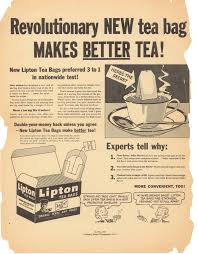Dear Oliver,
Tea bags are here to stay. Yes, Americans like convenience and when it was finally offered in the form of little bags filled with tea in the early 20 th century there was no going back. It seems there are two main stories detailing the invention of tea bags. The first story centers on two Wisconsin women, Roberta C. Lawson and Mary Molaren. Gizmodo states, “On August 26, 1901, the two intrepid women filed a patent (US723287) for a rather unique (at the time) ‘Tea-Leaf Holder’ that is remarkably similar to the modern tea bag.”
Their prototype resembles designs still used today to measure the right amount of tea for a single cup. The women were concerned with wastefulness and the whole drinking experience. According to Time they wrote, “only so much of tea-leaves is used as is required for the single cup of tea.” And, their application included, “the bag needed to hold the tea leaves together so that they didn’t float into the drinker’s mouth, but not so tightly that the water could not circulate through them to be infused. Their design used a stitched mesh fabric.” This patent was granted March 24, 1903. Although this patent was accepted, it does not seem there was yet widespread information or use of the mesh-type bag.
So, according to Teadonist, in 1908 another person, Thomas Sullivan, “packaged tea samples for his customers by wrapping the leaves in small, silk bags…. some customers didn’t realize that the leaves were then supposed to be emptied out, and instead simply dunked the bag into the water,” thus creating another early version of the single-cup tea bag. “However, silk bags weren’t ideal for steeping standard loose-leaf tea, as they are a little too fine and expensive for single serve,” reports Teadonist.

He then started experimenting and replaced the silk with gauze. The silk was expensive and very dense, making them less than ideal for daily use. Finally, he “further tweaked things for better steeping by filling the tea bags with fannings, the broken tea stalks, and tea dust leftover from processing the tea.” Like now, marketing was the key to success and it seems to be the reason Sullivan is often named as the inventor of modern-day tea bags.
His campaigns proved successful and early tea drinkers requested more and more of his tea that was packaged in the small bags. In addition, Sullivan’s bags, which were often filled with low quality fannings, steeped quickly and easily. Although this lesser tea was a problem for some it was often overlooked. “….and before long the little paper pouches were filled with the lowest grades of tea,” Florence Fabricant of the New York Times writes. “Consumers did not object. In fact, they like the fact that the minute particles in tea bags required but a few seconds in hot water to produce deeply colored, strong flavored liquid.”
It is no surprise that today tea sold in prefilled bags is highly popular. According to
TheSpruceEats, “Statistics on the preference/use of tea bags show that tea bags are used by as many as 98 percent of Americans and 96 percent of U.K. residents.
Furthermore, tea bags are widely used in India, Japan, and elsewhere.”
And, regarding the varying shapes, “researchers have shown that the shape doesn't matter—its all about size. This means that round tea bags are no better than square or rectangular ones, but 3-D shapes (such as pyramid bags) are likely a better choice because they give the leaves more room to infuse.”
Experts still agree that steeping in prefilled bags does come in as a close second to loose-leaf in the tea flavor wars. “Tea bags restrict the amount of space that tea leaves have in which to unfurl during the steeping process. This means that whole-leaf teas will likely release only some of their flavor and nutrients into the cup or pot and that much of the nuance and benefit found in high-quality tea will be lost when it is steeped in a tea bag.”Finally, even with potential flavor compromises, the bottom line on prefilled tea bags is that they are super convenient and economical. That packs a mighty punch with consumers. So, to state it again, the tea bag is here to stay.

(photos from Google image)


